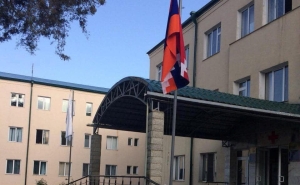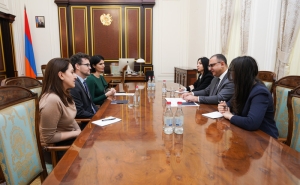Amaras: One of the Most Important Religious Centers of Artsakh

Amaras is one of Artsakh’s monasteries which faced a hard fate from the begging of its construction but at the same it is a resilient monastery that has been rebuilt every time it has been destroyed. Having a special place among the monasteries located in the territory of Artsakh, Amaras Monastery is associated with the first steps of the spread of Christianity in Artsakh and Utik.
According to medieval chroniclers Faustus Byuzand and Movses Kaghankatvatsi, St. Gregory the Illuminator founded the Amaras Monastery at the start of the fourth century. Amaras was the burial place of St. Gregory the Illuminator's grandson, St. Grigoris (died in 338).
St. Grigoris was originally buried at the eastern end of the now vanished St. Gregory church. In 489 Vachagan III the Pious, king of Caucasian Albania, renovated Amaras, restoring the church and constructing a new chapel for the remains of St. Grigoris. In later centuries a church was built over this chapel-tomb.
At the beginning of the fifth century Mesrop Mashtots, the inventor of the Armenian Alphabet, established in Amaras the first-ever school that used his script.
During its long history the monastery was plundered and destroyed several times by Arab and Mongol raids, including that of the Mongolian hordes headed by Tamerlan (1387). According to the legend, Tamerlan lined his soldiers from Amaras to river Araks and ordered them to throw the stones of the destroyed walls into the Araks River, passing them down the approx. 35km chain. But, again as the legend says, the invaders had hardly left, when the monastery was again rebuilt by Armenians by the same way (standing in line they passed the stones upwards), findarmenia.org reports.
During another Mongol invasion the monastery lost a large number of its treasures including Grigoris`s crosier and a golden cross incrusted with 36 precious stones, mshakuyt.com reports.
When Eastern Armenia was joined to Russia in the 19th century, Amaras with strong fortification structure was used as a fortress for Russian imperial troops.
The Armenian Apostolic Church reclaimed the monastery in 1848. The monastery's church appears to have been severely damaged during the period of military occupation, to the extent that a new church had to be constructed on the site of the old one. This new church, dedicated to St. Grigoris, was built in 1858 and paid for by the Armenians of the city of Shusha. It still survives and is a three-nave basilica constructed from bright white stone.
The monastery was abandoned during the Soviet period. It was reopened in 1992.
Despite its hard fate Amaras Monastery today serves as a functioning monastery of the Artsakh Diocese. Every year it opens its doors to hundreds of visitors.
-
 17:08
17:08The regular session of the Anti-corruption Policy Council takes place in Jermuk
-
 15:05
15:05The Prime Minister sends congratulatory messages to the supreme leader of Iran and the President of Iran
-
 11:11
11:11Armenia sends earthquake aid to Turkey
-
 10:43
10:43Commemoration of the Pontiff St. Sahak Partev
-
 09:16
09:16Some roads are closed and difficult to pass in Armenia
-
 19:55
19:55Phone conversation of the Foreign Minister of Armenia with the U.S. Assistant Secretary of State for European and Eurasian Affairs
-
 18:30
18:30Prime Minister Pashinyan and President Khachaturyan meet
-
 18:20
18:20Ararat Mirzoyan with Co-Chairman of the OSCE Minsk Group of France Brice Roquefeuil
-
 17:01
17:01Humans could land on Mars within 10 years, Musk predicts
-
 16:45
16:45France, US urge 'immediate' end to Nagorno Karabakh blockade
-
 16:01
16:01Blockaded Nagorno Karabakh launches fundraiser to support quake-hit Syria
-
 15:59
15:59Earthquake death toll in Turkey rises to 18,342
-
 15:43
15:43Ararat Mirzoyan Held a Telephone Conversation with Sergey Lavrov
-
 15:06
15:06French president rules out fighter jet supplies to Ukraine in near future
-
 14:47
14:475 Day Weather Forecast in Armenia
-
 14:44
14:44President Vahagn Khachaturyan wrote a note in the book of condolences opened in the Embassy of Syria in Armenia
-
 14:20
14:20Azerbaijan’s provocations impede establishment of peace and stability – Armenian FM tells Russian Co-Chair of OSCE MG
-
 12:57
12:57France representation to OSCE: Paris calls on Azerbaijan to restore freedom of movement through Lachin corridor
-
 11:40
11:40Command of Kosovo forces highly appreciated preparation of Armenian peacekeepers
-
 10:16
10:16The United States withdrew from sanctions against Syria for six months the provision of assistance after the earthquake
day
week
month
Humidity: %
Wind: km/h









